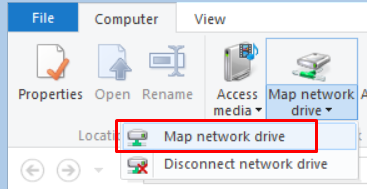

Note: this is where you will soon identify the hoarders in your organization. content that needs to be retained, but not in SharePoint.
#Sharepoint mapped drive archive

There are different strategies you could suggest for doing the clean-up, but generally you will end up with 4 buckets: This is why executive support (Tip #1) is so important. Clean-up can potentially take a lot of time by the owner of the content. (Refer to my blogpost SharePoint Online List View Threshold for more information) There is a 5000 View List Threshold in SharePoint and you need to ensure you are remaining within it.

An example of a tool that will provide this type of information is Treesize although there are likely others on the market. This will also give the migration team an idea of the number of files about to be migrated into SharePoint which is an important thing to know both in terms of the # of items as well as the overall storage. and the output can be provided to the content owner to assist them in their cleanup (Tip #4). The intent of this tool is to identify what kinds of files exist, what can be deleted, automatically delete duplicate files, etc. Tools can detect things like duplicate files, size of files, folder structure, etc.

You will benefit from having a tool to analyze the content you’re about to migrate into SharePoint. The takeaway? This is not a “conveyer belt” type of project. There are tangible benefits of moving content to SharePoint, but it does require some up-front planning and work to realize some of them. I will demonstrate some of these in subsequent tips. The only thing accomplished with this approach is content is no longer taking up space on your network drives. I can’t stress enough how important it is NOT to do this. If you have a mess on your shared network drive, migrating it into SharePoint “as-is” will just move the mess. Make sure your leadership understands this.
#Sharepoint mapped drive free
Perhaps give them a presentation (feel free to take some of these tips if you want) on the value-add SharePoint brings to the table, and why it needs to be more than just a “lift and shift” approach. You need to demonstrate to your organization’s leadership how messy, complicated, and slow this process can be.Unless the organization’s leadership has identified this as a priority to them, you will likely not get the attention/dedication you require. You will need to work with people throughout the organization, the “owners” of the content, to clean up what’s there and identify what should be moved to SharePoint.The Leadership team in your organization has likely identified the need to move content off shared network drives since they were promised the goodness of SharePoint to store content and are wondering why we still have them. Let’s face it this is not an exciting project to be on. Put your Information Management/Architecture hat on.Work with the team to build their new home.In this post I’ll share my 10 tips for getting thru these messy migrations in a more controlled manner – one that will allow your organization to realize the benefits of having this content stored in SharePoint as opposed to a network drive.Īpplies to: SharePoint On-premises, SharePoint Online. If you don’t do this, you run the risk of ending up with a SharePoint mess. Each migration is unique and requires up-front planning, preparation and therefore time to do it right. The migration process is not a cookie-cutter, conveyer belt one even if people perceive it to be that way. I don’t mean to suggest wrapping chocolates is like SharePoint migrations, however the conveyer belt analogy partly holds true. In my experience, this is usually not the case.įor those unfamiliar with the notorious Lucille Ball skit pictured above, here is a link. I am neck-deep in one of these migrations right now and have discovered there are expectations this process should be straightforward and therefore quick. Migrating this content is a challenging and messy task one that many of us are being asked to do. Whether an organization has been using SharePoint for a while or just starting down that road, many will still have large shared network drives holding some content that should rightfully belong in SharePoint.


 0 kommentar(er)
0 kommentar(er)
